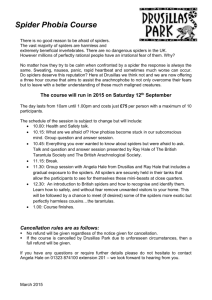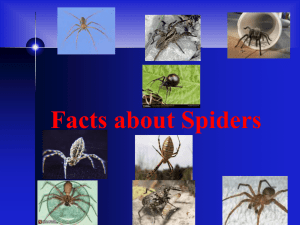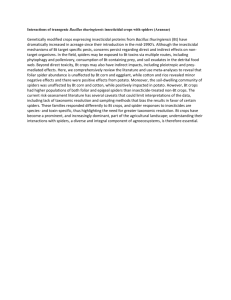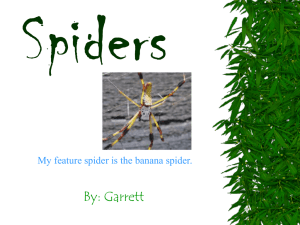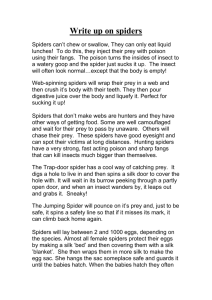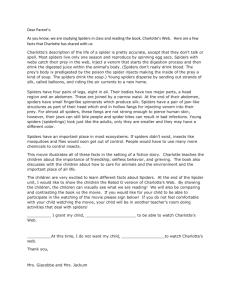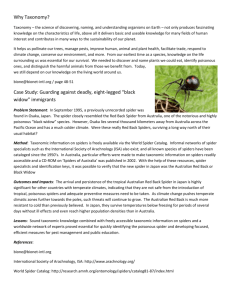P2154 Spiders: Brown Recluse & Black Widow
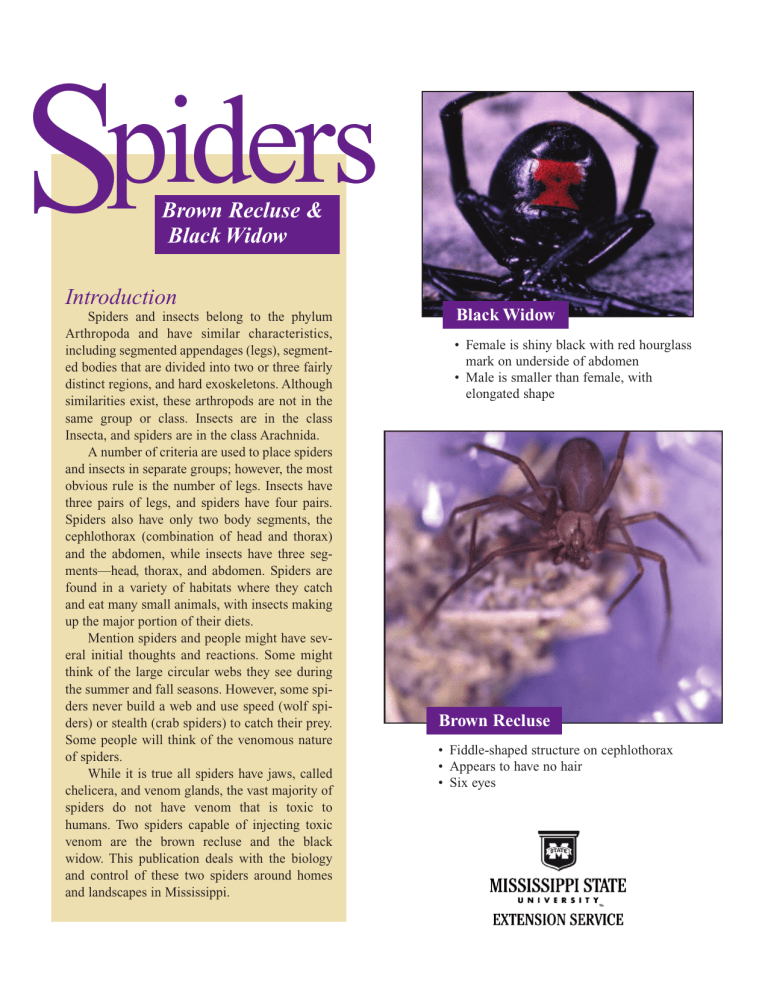
S
piders
Brown Recluse &
Black Widow
Introduction
Spiders and insects belong to the phylum
Arthropoda and have similar characteristics, including segmented appendages (legs), segmented bodies that are divided into two or three fairly distinct regions, and hard exoskeletons. Although similarities exist, these arthropods are not in the same group or class. Insects are in the class
Insecta, and spiders are in the class Arachnida.
A number of criteria are used to place spiders and insects in separate groups; however, the most obvious rule is the number of legs. Insects have three pairs of legs, and spiders have four pairs.
Spiders also have only two body segments, the cephlothorax (combination of head and thorax) and the abdomen, while insects have three segments—head, thorax, and abdomen. Spiders are found in a variety of habitats where they catch and eat many small animals, with insects making up the major portion of their diets.
Mention spiders and people might have several initial thoughts and reactions. Some might think of the large circular webs they see during the summer and fall seasons. However, some spiders never build a web and use speed (wolf spiders) or stealth (crab spiders) to catch their prey.
Some people will think of the venomous nature of spiders.
While it is true all spiders have jaws, called chelicera, and venom glands, the vast majority of spiders do not have venom that is toxic to humans. Two spiders capable of injecting toxic venom are the brown recluse and the black widow. This publication deals with the biology and control of these two spiders around homes and landscapes in Mississippi.
Black Widow
• Female is shiny black with red hourglass mark on underside of abdomen
• Male is smaller than female, with elongated shape
Brown Recluse
• Fiddle-shaped structure on cephlothorax
• Appears to have no hair
• Six eyes
Brown Recluse
(Loxosceles reclusa)
Description
The body of this spider, excluding the legs, is between
3/8 inch (9.5 mm) and 1/2 inch long (12.7 mm) and 3/16 inch (5 mm) wide. The legs are long and slender, making the body appear larger than its actual size. Coloration is variable, but generally it is brown to yellowish brown, with the abdomen darker than the cephlothorax.
The main identifying mark found on the recluse is the
“fiddle-shaped” structure located on the front of the cephlothorax. For this reason, some people call them violin spiders. The wider part of the fiddle is near the head, with the bow or handle starting about the middle of the cephlothorax and running toward the abdomen. The fiddle is darker than the surrounding body and stands out against the lighter background.
The body of the spider appears slick or void of hair, but when viewed under magnification, it is covered with small, brown hairs. This covering of hair gives the abdomen a somewhat velvety appearance. You can identify a brown recluse by its eyes—the recluse and its relatives have six eyes, while most other spiders have eight.
Habitat
The brown recluse is found statewide in Mississippi and is typically thought of as an “indoor” spider, but populations do exist in outdoor situations. For example,
University of Arkansas researchers kept site-collection data on brown recluse spiders from May 5, 1962, through
December 31, 1964. A total of 626 spiders were collected during this period, and 196 spiders, or 31 percent, were collected from outside locations.
The predominant outdoor site was under large, flat rocks in the rocky bluff habitat of north to northwest
Arkansas. Other outdoor collections came from under bark and from around debris piles. While the rocky bluff habitat exists only in northeast Mississippi, the other habitats are common and would provide areas of survival for the spiders in natural settings.
Although the brown recluse spider can be found outside, most are found in structures of various types. Of the
626 spiders reported in the above study, 298 spiders (47 percent) were collected from homes, 74 (12 percent) came from schools, and a miscellaneous building category showed a total of 58 spiders (9 percent). In buildings, the spiders were found in places that included boxes, stacks of papers, attics, old shoes, little-used clothing, closets, under furniture, behind picture frames, and in window wells and cabinets.
Brown recluse has six eyes
Most spiders have eight eyes
Most evidence would support a dry, dark, undisturbed area as the habitat of choice for this spider. There are times, however, when brown recluse spiders are found crawling about in the middle of a well-lit room with ongoing activities. This behavior does not fit the expected norm for the spider and, at the present time, there is not an explanation for its presence under these circumstances.
The brown recluse spins a rather nondescript web with threads that run in all directions. When fresh, the web is whitish in color, but with time, it collects dust and becomes an off-white or grayish-white color. This structure is used as a resting site, retreat, or nursery—it is not used to catch prey.
Biology
Laboratory data show that the recluse is a fairly longlived animal. According to the data, 32 males lived an average of 543 days, and 20 females lived an average of 628 days. This may not be the norm for spiders existing in nature or even in a somewhat protected structure, but it does point to a possible life span of 13 to 18 months.
There are three stages in the growth of the recluse.
These stages are egg, immature (spiderling) with eight stages, and adult. The eggs are not laid individually but are placed in a sac with each sac containing an average of 50 eggs. A female produces one to five sacs over her life span, with the majority of the egg cases produced during May,
June, July, and August. The sacs have not been recorded during the months of October, November, December, and
January. It takes an average of 336 days to go from egg to adult spider (range 266 to 444 days).
Some spiders, like this wolf spider, never build a web and use speed to catch its prey.
Brown recluse bite in the early stages of necrosis.
Brown recluse bite on leg 4 months after the bite.
Venom
Male and female brown recluse spiders are capable of biting and injecting a necrotic poison into its victims.
Reaction to the bite depends on a number of factors, including skin thickness at the point of the bite, amount of venom injected, individual sensitivity, and time from the last bite to the present bite.
The bite itself is apparently not painful to most victims at first, since the victims often report they were not aware of when the bite occurred. The symptoms associated with the bite can vary from person to person, and the following description may not fit every case.
The first symptoms occur 2–6 hours after the bite.
These symptoms are itching, swelling, and redness at the puncture site. A small, whitish area will surround the reddened area. A small, pimple-like structure will form soon after, followed by a blister. As the venom spreads, the wound site may become bluish or purplish due to a restricted blood flow and/or a destruction of red blood cells. At some point in the process, a black scab—similar to a burned area—may form; this falls off in about 2 weeks and reveals an ulcerated wound. Healing is slow, and it may take 6–8 weeks or longer for the wound to heal.
The sooner treatment is begun the better; however, there is no agreement on the treatment regimen. Past treatments have included antibiotics and corticosteroids to treat infection and relieve inflammation, and surgical removal of damaged tissue. In some cases, dapsone has been used to treat these lesions. Whatever the case, brown recluse spider bites require a physician’s care.
Black Widow
(Latrodectus mactans)
Description
There are five spiders in the “widow” group. One is restricted to southern Florida, and one is found in the western parts of the United States and Canada. Another one that was previously only found in Florida, the brown widow, Latrodectus geometricus , has recently expanded its range and now occurs all over the southeastern United
States, including Mississippi.
Biology and control of the brown widow is similar to that of the black widow and will be combined here. The widow spider most often referred to as the black widow in
Southern states is the species L. mactans . Another widow spider is the northern widow found across much of the northern United States and into New England.
The female black widow is most often seen. It has a characteristic shiny black color with a red hourglass mark on the underside of its abdomen. Occasionally, there are red dots or hash marks on the upper side of the abdomen, as well. The body, excluding legs, is 7/16 inch long (11 mm) and 5/16 inch (7.9 mm) to 3/8 inch (9.5 mm) wide.
With a distinct globular shape, the abdomen is larger than the cephlothorax. The first and fourth pairs of legs are long and slender, which adds to the overall perception of size. Black widow males (not reported to have caused any venomous bites) are considerably smaller than the female black widow, and their abdomens have an elongated shape rather than the globular shape of the female.
Habitat
This spider is found almost exclusively in outside habitats. It can be found in the crawl spaces of houses, in water meter boxes, under rocks, in stumps or logs, around refuse piles, in brick piles, and in stacks of firewood. If spiders use buildings, they tend to be old abandoned barns, houses, sheds, or the little-used sections of garages or basements.
Spider populations, in general, will fluctuate from year to year; however, with the black widow, high populations in a given area are rare. The controlling factors may be disease, predators, lack of suitable habitat, and/or competition, along with some degree of cannibalism among the spiders.
A black widow’s web is an indistinct mesh of webbing in which the spider hangs with its head pointed down. In this case, the web is used to snare prey that ventures into the area. If the web is built in a somewhat open area, the spider might be under a nearby dirt clod, rock, or piece of debris during the day, since they will avoid light. The black widow returns to the web at night and waits for an insect or other arthropod to become stuck in the web.
Biology
The black widow has three growth stages—egg, immature (spiderling) with seven to nine stages, and adult spider. The spider spends the winter as a late-stage immature or an adult in a protected site. In the spring the spiders become active, and the males seek out and mate with mature females.
Soon after mating, females start producing egg sacs and will produce three to six during the spring and early summer. Each sac will contain an average of 255 eggs. Black widow egg sacs are smooth and tan in color, whereas brown widow egg sacs are “prickly,” similar to a cocklebur.
Female widow spiders usually die by the end of summer or early fall. Young spiders will disperse from the nest site by ballooning, which is accomplished by crawling up grass blades, stems, or other upright objects on windy days and extruding strands of silk from their silk glands. As the wind catches these strands, the young spiders are lifted into the air and deposited at some distant point. Once in this area, they seek out a suitable site to construct a web.
Venom
As with the brown recluse, black widow bites may go unnoticed. The chelicerae are only about 1 millimeter in length and may have trouble breaking the skin at some points on the body. The amount of venom injected, the age of the victim, and the elapsed time from the last bite until the present bite are some factors that determine severity of symptoms experienced by the victim.
Shortly after the bite (30–45 minutes), the skin around the puncture site might become red with a central white or blanched area. A close examination might reveal two puncture points. The venom is a neurotoxin (acts on the nervous system) and, as the venom begins to spread, pain increases and a contraction or cramping might be noted in the thighs, lumbar region, abdomen, or chest area. This muscle cramping or rigidity is particularly severe in the abdominal muscles. Muscle cramps will make walking difficult in some patients, and a slurring of speech may be noted.
Black widow and brown widow bite treatments might include an antivenin given intramuscularly for 1 or 2 days, plus pain management using muscle relaxers or calcium gluconate. If two doses of calcium fail to relieve pain, morphine sulfate may be used. A physician must prescribe these treatments. Warm baths may help relieve muscle spasms.
Control
of
Black Widow and Brown Recluse Spiders
Because black widow spiders and brown recluses live in different habitats, the methods used to control these spiders differ considerably. Black widows (and also brown widows) are more likely to occur outdoors and are rarely encountered inside occupied buildings that are heated and cooled (note that “rarely” does not mean “never”), although they sometimes occur in garages, basements, and unheated storage buildings. On the other hand, brown recluse spiders are rarely seen outdoors in Mississippi and are much more common indoors. Heavy infestations of brown recluses may occur in inhabited buildings that are heated and cooled, as well as in unheated storage areas.
Control of Black Widow Spiders
Spot Treatment : Eliminating individual black widow spiders as they are discovered, either by crushing them or by spraying with an appropriate contact insecticide (see
Table 1), is one of the most practical ways to control black widows. Occasionally, you may encounter a web teeming with hundreds of newly hatched spiderlings, and you will have to use a spray to control these spiderlings because they are too small and too numerous to control by crushing.
Also, be sure to check for egg sacs and eliminate these.
Black widow populations are cyclic. Some years, populations are so low that black widows are rarely encountered, but in outbreak years there may be dozens of nesting females in a single backyard. Heavy populations often occur in enclosed crawl spaces under buildings. It is rarely necessary or practical to apply broadcast insecticide treatments to an entire yard or area to control black widows.
Habitat Reduction : The key to managing black widow spider populations is to learn to recognize the types of areas where they like to build their webs, and to eliminate these situations as much as possible. Black widow spiders normally nest in dark, protected sites located at or near ground level. This includes stacks of lumber, bricks, concrete blocks, flower pots, or similar materials; piles of wood, tree limbs, or other debris; in water meters, electrical boxes, or similar places; in crawl spaces under buildings or steps; and in bushy, low-growing plants.
Sometimes black widows are found nesting in more exposed areas, such as under eaves of buildings, but this is rather uncommon.
Proactively reducing suitable black widow nesting sites is the most effective thing you can do to help reduce black widow populations around your house. Be sure to wear gloves and long-sleeved shirts when removing and handling such items. Most bites occur when people unknowingly press a spider against their skin or place an ungloved hand into the web of a female guarding her egg sac. Habitat reduction is especially important in play yards and other areas frequented by very young children. Inspect play yards regularly, giving special attention to areas where black widows may build their webs.
Awareness and Education : Black widows build three-dimensional webs that have no distinct pattern (not wheel-shaped, etc), are usually in a dark, secluded place near the ground, and are made of unusually strong silk.
Being able to recognize black widow webs, the spiders themselves, their egg cases, and the places where black widows usually nest helps reduce your chances of being bitten. Teach young children how to recognize and avoid black widows and the kinds of places they are likely to occur. Wear gloves and other appropriate protective clothing when working in areas where you might encounter black widows.
Control of Brown Recluse Spiders
Brown recluse spiders are common throughout the state.
Low numbers occur in most homes and buildings, but some homes and buildings have unusually heavy infestations. Heavily infested buildings are usually older buildings, buildings constructed in such a way that they contain large numbers of cracks and crevices where spiders can hide, or buildings with large numbers of stored items. Most infestations are likely introduced into a building when brown recluses are unknowingly transported from an infested building in a box of stored items, a piece of used furniture, a piece of electronic equipment, or similar items.
Brown recluse spiders prefer to nest indoors in dark, undisturbed areas. This includes areas such as closets and storage cabinets; under beds; in and under furniture; in boxes; in and behind bookshelves; behind pictures and other wall hangings; in light fixtures and behind wall plates for electrical switches and outlets; in wall, floor, and ceiling voids; and in other dark cracks and crevices.
Keeping such areas clean and well-organized helps discourage spiders. Storing items—especially cloth items—in insect-tight plastic containers (rather than cardboard boxes) is especially helpful.
Brown recluses will also inhabit attics and other areas of the home that are not heated and cooled. In many cases, spiders tend to move into attics in the fall of the year as temperatures cool, but during the summer, Mississippi attics often reach temperatures that are inhospitable to spiders. Owners of infested homes may notice an increase in brown recluse activity in the living areas in late spring as warming temperatures cause spiders to move out of attics and similar locations.
Cleaning and Decluttering : Systematic cleaning and decluttering is the most important step in attempting to control heavy infestations of brown recluse spiders. This means going through each room, closet, and storage area in a systematic manner to declutter, clean, and apply insecticides where appropriate.
Note that cleaning and decluttering is actually more important than spraying an insecticide when attempting to control brown recluse spiders. The basic plan is to remove all items from the area, checking them for spiders as you do so; clean/vacuum all corners, cracks, crevices, and other potential refuge areas; treat the appropriate areas of the empty room or storage area; treat the backs, bottoms, and other appropriate crevices of furniture; allow sprays to dry; and then return items to the room.
The following list gives a general outline of how to approach treating a room or storage area for a heavy brown recluse infestation. This is a lot of work, but it takes a lot of work to do a thorough brown recluse treatment. You can do less, but you will get less control. Many homeowners are reluctant to go to the amount of effort it takes to do a thorough brown recluse treatment—until a family member gets bitten.
If you are finding several brown recluse spiders a month and are sure of their identification, then you definitely have a heavy infestation that justifies the effort necessary to control such an infestation—before someone gets bitten. A thorough, properly conducted treatment effort will result in greatly reduced spider populations, which reduces the chances of someone being bitten. Although spider populations will gradually rebuild, benefits of such an intensive control effort can last for many months.
Controlling Heavy Brown Recluse Infestations
• Have a vacuum and other appropriate cleaning tools on hand.
• Have appropriate insecticide(s) and application tools on hand (see Table 1).
• Read and understand the label of the insecticide(s).
• Systematically remove all items from the area, checking for spiders as you do so.
• Remove and empty drawers of dressers and other furniture.
• Remove books from book cases.
• Remove, empty, and check all storage boxes.
• Move beds, sofas, easy chairs, and other items away from walls and turn on back or side.
• Vacuum/clean interior, back, and bottom of all furniture.
• Remove pictures and other wall hangings and clean or vacuum backs.
• Vacuum room/closet thoroughly, especially corners, cracks, and crevices.
• Apply insecticide to baseboards, cracks, and crevices of the empty room (following the insecticide label).
• Treat the back, bottom, and interior of empty furniture
(following the insecticide label).
• Allow spray to dry before replacing drawers, clothing, books, and other items.
• Return items to the room.
Do not underestimate the value of vacuuming, cleaning, and decluttering in spider control. Thorough vacuuming removes many live spiders, including young spiderlings that you would not otherwise notice, as well as eggs, webs, and other insects that spiders would use as prey.
Recluse Awareness : If you live or work in a building where brown recluses are common, you should take precautions to reduce the potential for being bitten. This does not mean you have to be paranoid about spiders, but because brown recluses often hide and nest in the folds of infrequently used clothing and bedding, it is wise to carefully check such items before using them for the first time after a long period of storage. Doing so could prevent a bite from a spider that has been living in the coat that has been hanging in the basement since last winter or the sleeping bag that has been stored in the attic since the last camping trip. Most bites occur when a recluse is unknowingly pressed against the skin.
Spider Identification : When you encounter a spider indoors, it is helpful to note whether or not it is a brown recluse. Most spiders found inside buildings are not brown recluses, but there are several species that superficially resemble brown recluses, at least in general body shape.
These include wolf spiders, which are non-venomous, outdoor-dwelling spiders that often wander into buildings but do not live inside buildings. Several other species of non-venomous spiders do live indoors and occur in the same types of situations preferred by brown recluses. These include southern house spiders, spitting spiders, cellar spiders, and common house spiders. The treatment procedures recommended for controlling brown recluses will also control these other species of indoor-dwelling spiders.
Traps : Several companies sell sticky glue traps that can be placed along walls to capture spiders and other crawling insects. These traps are not especially useful in controlling spiders, but they can help determine the species present and
the level of infestation. Catching two or three wolf spiders in your sticky traps every month may indicate a need to install a new door sweep, but catching brown recluse spiders indicates a need for a more intensive spider control effort, as described above.
Insecticides for Spider Control : Insecticides containing active ingredients such as cyfluthrin, cypermethrin, deltamethrin, lambda-cyhalothrin, permethrin, tralomethrin, or even natural pyrethrins (pyrethrum) can be applied according to label directions to control spiders that can be directly targeted with the spray. Natural pyrethrins will not provide residual control, but products containing the other active ingredients will provide relatively long residual control, especially when applied indoors where they are not exposed to sunlight. Such products can be applied to voids, cracks, crevices, and baseboards for control of brown recluses and other spiders that live in closets and other storage areas, or as spot sprays. Be sure to read and follow all label directions.
Insecticides formulated as wettable powders (WPs) provide better residual spider control than ready-to-use formulations, but WPs can be difficult to find in packages labeled for homeowner use. Demon WP/Cyper WP (cypermethrin) is one example of a wettable powder type insecticide that is often used by pest control companies for spider control.
Wettable powder products must be diluted in water and applied using a pump-up hand sprayer.
Some of the other active ingredients mentioned in the table are available as liquid concentrate sprays, which must also be mixed with water and applied using a pump-up hand sprayer. However, many of these active ingredients are also available in ready-to-use sprays, which are pre-diluted and sold in trigger-pump type sprayers. These ready-to-use sprays or aerosol sprays are a convenient means of treating limited infestations and are the most common formulation offered to homeowners for indoor use. Many insecticides are also formulated and sold as total release aerosol foggers, but these are not as effective as sprays that can be directed into cracks, crevices, and voids.
In situations where brown recluses are nesting in wall voids, other voids, or deep cracks and crevices, dusts containing the active ingredient deltamethrin can be especially useful. Use a specially designed bulb duster to inject small amounts of dust into such voids, cracks and crevices. If necessary, drill small holes to allow dust to be injected into voids that are not otherwise accessible. Dusts containing 0.05 percent deltamethrin are readily available at local retailers, but bulb dusters may have to be specially ordered. Professional pest control companies use a product called DeltaDust, which contains 0.05 percent deltamethrin.
Hire a Professional : Many homeowners rely on professional pest control companies to control heavy brown recluse infestations because they have access to an array of effective insecticides and have the knowledge and equipment to apply them properly and safely. If you do use a professional pest control company, it is still necessary to remove boxes and other items from storage areas and other areas to be treated, and to check for spiders inside boxes, before the treatment is applied. Visit with the pest control technician before he or she arrives to apply the treatments to discuss what you need to do to prepare the areas to be treated.
Table 1. Examples of indoor treatments for spider control.
Active Ingredient
Bifenthrin (0.05%)
Cyfluthrin (0.05%)
Deltamethrin (0.02%)
Lambda-cyhalothrin (0.03%)
Permethrin (0.25%)
Tralomethrin (0.03%)
Deltamethrin (0.05%)
Deltamethrin (0.05%)
Brand Name (example)
Ready-to-use sprays
Ortho Home Defense Max
Bayer Home Pest Control Indoor & Outdoor Insect Killer
Bonide Household Insect Control
Spectracide Bug Stop Indoor Outdoor Insect Killer
Viper RTU
Schultz RTU Home Insect Killer
Dusts
Terro Ant Dust
Enforcer Fire Ant Killer
Photography: Black widow and wolf spider photographs from Ross Hutchins Photographic Collection, Mississippi State University; photograph of brown recluse bite on leg courtesy of Jerome Goddard and the Mississippi Department of Health. Spider bite in early stage of necrosis, reprinted from Goddard's Physicians Guide for Arthropods of Medical Importance . 1993. CRC Press, Inc., Boca
Raton, FL, courtesy of Dr. Tom Brooks.
Revised by Dr. Jerome Goddard , Associate Extension Professor, and Dr. Blake Layton , Extension Professor, from the original by
Dr. James H. Jarratt, retired Extension Entomologist, and Dr. Jerome Goddard (then at the Mississippi Department of Health).
Discrimination based upon race, color, religion, sex, national origin, age, disability, or veteran’s status is a violation of federal and state law and MSU policy and will not be tolerated. Discrimination based upon sexual orientation or group affiliation is a violation of MSU policy and will not be tolerated.
Publication 2154
Extension Service of Mississippi State University, cooperating with U.S. Department of Agriculture. Published in furtherance of Acts of
Congress, May 8 and June 30, 1914. JOE E. STREET, Interim Director (rev-500-08-10)
